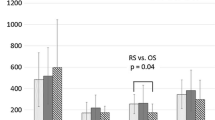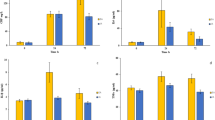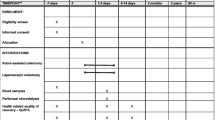Abstract
PURPOSE: To objectively evaluate the benefits of laparoscopic procedures for colorectal carcinoma, a prospective study to measure the stress response to laparoscopic surgery (n=15) compared with open surgery (n=12) was undertaken. In addition, to compare the various parameters relevant to surgical stress, the major surgery group (transthoracic esophagectomy for esophageal carcinoma, n=4; and left upper abdominal evisceration for gastric carcinoma, n=3) was assigned. METHODS: Peripheral blood samples were obtained to measure serum interleukin-6, C-reactive protein, peripheral leukocytes, and lymphocyte counts. Additionally, the level of lymphocyte apoptosis was quantified using flow cytometry. RESULTS: The interleukin-6 and C-reactive protein levels were significantly greater in the open group than in the laparoscopy group one day (P<0.05) and two days (P<0.05) after surgery, respectively. In the laparoscopy group, lymphocyte counts were significantly higher than in the open group two days after surgery. The laparoscopy and open groups did not differ significantly in their lymphocyte apoptotic index. In the major surgery group, the apoptotic index was significantly higher than in either the laparoscopy group or the open group in the early postoperative period. CONCLUSION: Changes in the various parameters pertinent to surgical stress evaluated in this study suggest that laparoscopic surgery for colorectal carcinoma leads to less postoperative stress than conventional open surgery.
Similar content being viewed by others
References
Okuda J, Tanigawa N. Colon carcinomas may be adequately treated using laparoscopic methods. Semin Colon Rectal Surg 1998;9:241–6.
Ortega AE, Beart RW Jr, Steele GD Jr, Winchester DP, Greene FL. Laparoscopic bowel surgery registry: preliminary results. Dis Colon Rectum 1995;38:681–5.
Wexner SD, Cohen SM. Port site metastases after laparoscopic colorectal surgery for cure of malignancy. Br J Surg 1995;82:295–8.
Cirocco WC, Schwartzman A, Golub RW. Abdominal wall recurrence after laparoscopic colectomy for colon cancer. Surgery 1994;116:842–6.
Cioffi WG, Burleson DG, Pruitt BA Jr. Leukocyte responses to injury. Arch Surg 1993;128:1260–7.
Baigrie RJ, Lamont PM, Kwiatkowski D, Dallman MJ, Morris PJ. Systemic cytokine response after major surgery. Br J Surg 1992;79:757–60.
Oka M, Hirazawa K, Yamamoto K,et al. Induction of Fas-mediated apoptosis on circulating lymphocytes by surgical stress. Ann Surg 1996;223:434–40.
Milsom JW, Böhm B, Hammerhofer KA, Fazio V, Steiger E, Elson P. A prospective, randomized trial comparing laparoscopic versus conventional techniques in colorectal cancer surgery: a preliminary report. J Am Coll Surg 1998;187:46–54.
Baumann H, Gauldie J. Regulation of hepatic acute phase plasma protein genes by hepatocyte stimulating factors and other mediators of inflammation. Mol Biol Med 1990;7:147–59.
Perlmutter DH, Dinarello CA, Punsal PI, Colten HR. Cachectin/tumor necrosis factor regulates hepatic acute-phase gene expression. J Clin Invest 1986;78:1349–54.
Castell JV, Andus T, Kunz D, Heinrich PC. Interleukin-6: the major regulator of acute-phase protein synthesis in man and rat. Ann N Y Acad Sci 1989;557:87–99.
Cruickshank AM, Fraser WD, Burns HJ, Van Damme J, Shenkin A. Response of serum interleukin-6 in patients undergoing elective surgery of varying severity. Clin Sci 1990;79:161–5.
Ohzato H, Yoshizaki K, Nishimoto N,et al. Interleukin-6 as a new indicator of inflammatory status: Detection of serum levels of interleukin-6 and C-reactive protein after surgery. Surgery 1992;111:201–9.
Harmon GD, Senegore AJ, Kilbride MJ, Warzynski MJ. Interleukin-6 response to laparoscopic and open colectomy. Dis Colon Rectum 1994;37:754–9.
Hewitt PM, Ip SM, Kwok SP,et al. Laparoscopic-assisted vs. open surgery for colorectal cancer: Comparative study of immune effects. Dis Colon Rectum 1998;41:901–9.
Halevy A, Lin G, Gold-Deutsch R,et al. Comparison of serum C-reactive protein concentrations for laparoscopic versus open cholecystectomy. Surg Endosc 1995;9:280–2.
Redmond HP, Watson RW, Houghton T, Condron C, Watson RG, Bouchier-Hayes D. Immune function in patients undergoing open vs laparoscopic cholecystectomy. Arch Surg 1994;129:1240–6.
Riddle PR, Berenbaum MC. Postoperative depression of the lymphocyte response to phytohaemagglutinin. Lancet 1967;1:746–8.
Espanol T, Todd GB, Soothill JF. The effect of anaesthesia on the lymphocyte response to phytohaemagglutinin. Clin Exp Immunol 1974;18:73–9.
Koopman G, Reutelingsperger CP, Kuijten GA, Keehnen RM, Pals ST, van Oers MH. Annexin V for flow cytometric detection of phosphatidylserine expression on B cells undergoing apoptosis. Blood 1994;84:1415–20.
Ishaque A, Al-Rubeai M. Use of intracellular pH and annexin-V flow cytometric assays to monitor apoptosis and its suppression by bcl-2 over-expression in hybridoma cell culture. J Immunol Methods 1998;221:43–57.
McCloskey TW, Chavan S, Lakshmi Tamma SM, Pahwa S. Comparison of seven quantitative assays to assess lymphocyte cell death during HIV infection: measurement of induced apoptosis in anti-Fas-treated Jurkat cells and spontaneous apoptosis in peripheral blood mononuclear cells from children infected with HIV. AIDS Res Hum Retroviruses 1998;14:1413–22.
Walsh GM, Dewson G, Wardlaw AJ, Levi-Schaffer F, Moqbel R. A comparative study of different methods for the assessment of apoptosis and necrosis in human eosinophils. J Immunol Methods 1998;217:153–63.
Toft P, Svendsen P, Tonnesen E, Rasmussen JW, Christensen NJ. Redistribution of lymphocytes after major surgical stress. Acta Anaesthesiol Scand 1993;37:245–9.
Author information
Authors and Affiliations
About this article
Cite this article
Nishiguchi, K., Okuda, J., Toyoda, M. et al. Comparative evaluation of surgical stress of laparoscopic and open surgeries for colorectal carcinoma. Dis Colon Rectum 44, 223–230 (2001). https://doi.org/10.1007/BF02234297
Issue Date:
DOI: https://doi.org/10.1007/BF02234297




